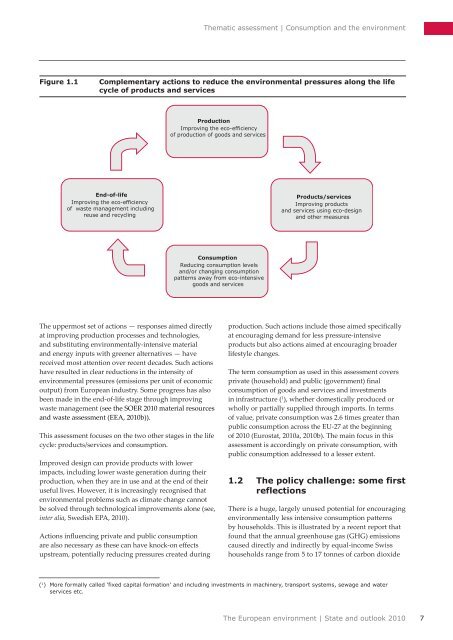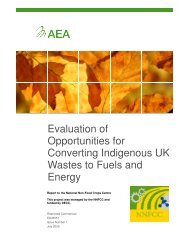Consumption and the environment (SOER2010) - European ...
Consumption and the environment (SOER2010) - European ...
Consumption and the environment (SOER2010) - European ...
Create successful ePaper yourself
Turn your PDF publications into a flip-book with our unique Google optimized e-Paper software.
Thematic assessment | <strong>Consumption</strong> <strong>and</strong> <strong>the</strong> <strong>environment</strong><br />
Figure 1.1<br />
Complementary actions to reduce <strong>the</strong> <strong>environment</strong>al pressures along <strong>the</strong> life<br />
cycle of products <strong>and</strong> services<br />
Production<br />
Improving <strong>the</strong> eco-efficiency<br />
of production of goods <strong>and</strong> services<br />
End-of-life<br />
Improving <strong>the</strong> eco-efficiency<br />
of waste management including<br />
reuse <strong>and</strong> recycling<br />
Products/services<br />
Improving products<br />
<strong>and</strong> services using eco-design<br />
<strong>and</strong> o<strong>the</strong>r measures<br />
<strong>Consumption</strong><br />
Reducing consumption levels<br />
<strong>and</strong>/or changing consumption<br />
patterns away from eco-intensive<br />
goods <strong>and</strong> services<br />
The uppermost set of actions — responses aimed directly<br />
at improving production processes <strong>and</strong> technologies,<br />
<strong>and</strong> substituting <strong>environment</strong>ally-intensive material<br />
<strong>and</strong> energy inputs with greener alternatives — have<br />
received most attention over recent decades. Such actions<br />
have resulted in clear reductions in <strong>the</strong> intensity of<br />
<strong>environment</strong>al pressures (emissions per unit of economic<br />
output) from <strong>European</strong> industry. Some progress has also<br />
been made in <strong>the</strong> end-of-life stage through improving<br />
waste management (see <strong>the</strong> SOER 2010 material resources<br />
<strong>and</strong> waste assessment (EEA, 2010b)).<br />
This assessment focuses on <strong>the</strong> two o<strong>the</strong>r stages in <strong>the</strong> life<br />
cycle: products/services <strong>and</strong> consumption.<br />
Improved design can provide products with lower<br />
impacts, including lower waste generation during <strong>the</strong>ir<br />
production, when <strong>the</strong>y are in use <strong>and</strong> at <strong>the</strong> end of <strong>the</strong>ir<br />
useful lives. However, it is increasingly recognised that<br />
<strong>environment</strong>al problems such as climate change cannot<br />
be solved through technological improvements alone (see,<br />
inter alia, Swedish EPA, 2010).<br />
Actions influencing private <strong>and</strong> public consumption<br />
are also necessary as <strong>the</strong>se can have knock-on effects<br />
upstream, potentially reducing pressures created during<br />
production. Such actions include those aimed specifically<br />
at encouraging dem<strong>and</strong> for less pressure-intensive<br />
products but also actions aimed at encouraging broader<br />
lifestyle changes.<br />
The term consumption as used in this assessment covers<br />
private (household) <strong>and</strong> public (government) final<br />
consumption of goods <strong>and</strong> services <strong>and</strong> investments<br />
in infrastructure ( 1 ), whe<strong>the</strong>r domestically produced or<br />
wholly or partially supplied through imports. In terms<br />
of value, private consumption was 2.6 times greater than<br />
public consumption across <strong>the</strong> EU‐27 at <strong>the</strong> beginning<br />
of 2010 (Eurostat, 2010a, 2010b). The main focus in this<br />
assessment is accordingly on private consumption, with<br />
public consumption addressed to a lesser extent.<br />
1.2 The policy challenge: some first<br />
reflections<br />
There is a huge, largely unused potential for encouraging<br />
<strong>environment</strong>ally less intensive consumption patterns<br />
by households. This is illustrated by a recent report that<br />
found that <strong>the</strong> annual greenhouse gas (GHG) emissions<br />
caused directly <strong>and</strong> indirectly by equal-income Swiss<br />
households range from 5 to 17 tonnes of carbon dioxide<br />
( 1 ) More formally called 'fixed capital formation' <strong>and</strong> including investments in machinery, transport systems, sewage <strong>and</strong> water<br />
services etc.<br />
The <strong>European</strong> <strong>environment</strong> | State <strong>and</strong> outlook 2010<br />
7








